



Already know what you're looking for? Quick Links | |||
Albino
There are a number of genes that can cause albinism, and the most common is tyrosinase, usually referred to as the "C locus". The C locus is responsible for albino in many species of mammal, and generally lightens or removes all (melanin-based) pigment, not just phaeomelanin. It can also
restrict pigment to certain areas, as in Siamese cats.
There is only one known C locus mutation in dogs (see below), and as yet no pure white dogs have tested positive for albino on this locus.
However, there are dogs that appear to be albinistic, so what is causing their colour?
Himalayan/Siamese Pattern
One of the biggest surprises in dog genetics recently has been the discovery of two dogs with a "siamese" pointed pattern.
Siamese/himalayan is a recessive form of heat-sensitive partial albinism where the pigment is found only in the coldest areas of the animal - the feet, nose, ears, and tail. The intensity of the colour varies according to the outside temperatures, with colder temperatures usually producing the darkest points. The eyes are generally blue, like other forms of albinism in dogs and cats. This gene is fairly common in many species of animal, but until now has not been found in dogs. It can occur in conjunction with any other genes, so theoretically a dog could be merle-pointed, liver-pointed, sable-pointed, or anything else. The I Locus
Until fairly recently it was thought that the C locus was responsible for the intensity of phaeomelanin (red) pigment in dogs, causing the difference
between rich Irish Setter red and the almost pure white seen on breeds such as the Samoyed and German Shepherd Dog.
The research for both of these loci is very new, and one has not yet been given a letter to identify it, as the gene markers are not yet clear. No commercial testing is available yet for this locus, so stay tuned for more information once we have a clearer idea of how it works. For now, you can find further information on this gene, KITLG, at the bottom of the page. The locus for the other gene identified has been labelled I (for Intensity). It appears to work as a simple recessive, with I having deeper pigment and i having paler pigment. Not all breeds appear to be affected by the I locus, and it's not clear whether I is fully or just partially dominant over i. However, testing is available and can help to distinguish between phaeomelanin shades in some breeds.
The I locus does not affect eumelanin in any way (although it seems the as-yet-unidentified KITLG may do, to some extent). The "dudley" noses and unpigmented eye rims sometimes seen in dogs with light-coloured phaeomelanin
are generally due to the recessive red gene and not the phaeomelanin dilution itself, and can usually be improved by careful breeding for strong pigment.
Genetic testing on Samoyeds has found them to be homozygous for both recessive red and recessive black.
Some geneticists have suggested that it is this combination of genes which causes them to be solid white. This would be because
recessive red stops the dog from producing eumelanin (black pigment) in the coat, and recessive black stops it from producing phaeomelanin (red pigment) in the coat. The
result would be a dog that couldn't produce any pigment at all in its coat, and so would be solid white (but with a fully-pigmented nose, because recessive red only
affects the coat and not the nose, eyes etc). However, there's no evidence to suggest
that this gene combination is in fact responsible for white, as solid white occurs in many breeds that do not have recessive black. It seems much more likely that it's simply down to an extreme dilution of phaeomelanin (red) on a recessive
red dog. Samoyeds do sometimes have pale cream ("biscuit") markings around the head/ears and tail, which shows they are able to produce red pigment.
Urajiro/Countershading
Some breeds of dog, most notably the Japanese Akita Inu and Shiba Inu, display a pattern known as "urajiro", or sometimes called "countershading". Urajiro
appears as symmetrical white points, usually on a red dog. The points are located in roughly the same places as on a tan-pointed (atat) dog, but of
course, normal tan points don't appear on red dogs, only black, liver, blue and isabella.
The urajiro gene hasn't been located yet, but it's possible it's connected to the other Intensity genes. It occurs only on red areas of the dog (which can include tan points, although this is uncommon as most tan-pointed breeds are selected for strong red colouration). Eumelanin masks are unaffected (see the example of Jersey the Shiba Inu below).
There can sometimes be confusion between urajiro and domino/grizzle (see E locus page), because domino can cause a very similar pale/white phaeomelanin point pattern. There's no reason why these genes can't occur together too, further complicating matters. However, domino only occurs in certain breeds, and can't occur with a mask. There are usually other indicators too, such as a striped nose on domino dogs. See below for two examples of "borderline" dogs, that could have urajiro or domino.
If you compare these two dogs, their patterns are more-or-less identical, even down to the facial markings and the tan areas remaining on the legs. If one is domino or a domino carrier (and the Finnish Lapphund very likely is), surely the other must be too. The terrier also looks like it may have a faint pink stripe down the centre of the nose, which is an indicator of domino. Without seeing this comparison, we would probably assume that the terrier is a normal tan-pointed dog (or creeping tan) with urajiro. The black areas remain unaffected (remember urajiro only affects phaeomelanin), so in this case the urajiro areas would not extend as far as they may do on a sable dog. However, the tan areas have been turned to white at the extremities. There is still fairly rich tan on the outside of the legs (see the Shiba Inus above - only the feet and inside of the legs are affected by urajiro), creating a tricolour effect. All of this would generally indicate urajiro, if we had no reason to suspect domino.
Schnauzers
Schnauzers are a very interesting set of breeds as a case study for dog genetics. The Miniature Schnauzer comes in four colours - solid black, solid white, salt-and-pepper, and black-and-silver (in the traditional tan pattern).
Salt-and-pepper is just like black-and-silver, but the black is replaced by grey. This is what makes the genetics of Schnauzers confusing - black-and-silver
and salt-and-pepper look like they're caused by the same gene, but we don't know of any genes like this.
In fact, salt-and-pepper and black-and-silver are caused by different A locus genes combined with phaeomelanin dilution.
This black-and-silver Schnauzer (photo also taken by Jessica Pilhede) looks like it has the same pattern of white as the salt-and-pepper above. However, the white on this
dog is caused by the tan point gene (at). Tan points are on the same locus as wolf grey, and produce a very similar sort of pattern, but
the upper parts of the body are a solid colour with no banding.
All Schnauzers have extreme phaeomelanin dilution. This means that agoutis become wolf greys (salt-and-pepper)
and black-and-tans become black-and-silvers. All of the phaeomelanin in the coat is affected, because Schnauzers don't carry any sort of urajiro
like the Shibas above, even though they look a little bit like they do.
Solid black Schnauzers have the dominant black gene (KB), which stops the agouti locus patterns from being expressed. A black Schnauzer is
genetically a salt-and-pepper or a black-and-silver, but is unable to express either of these. A salt-and-pepper or black-and-silver dog
must be kyky on the K locus in order to express its pattern.
Solid white Schnauzers are genetically recessive reds (ee on the E locus). Recessive red turns all of their black hairs to
red (recessive reds have a faulty mechanism which means they're unable to produce eumelanin, or black pigment), and then one of the phaeomelenin intensity genes turns them to white,
leaving their noses and eyes unaffected. White Schnauzers can be genetically black, salt-and-pepper or black-and-silver. The combination of recessive
red with intensity dilution is a fascinating one, because it's the only thing, except for white markings, which can hide any colour or pattern. There is
nothing that can "override" it, because it stops the production of all eumelanin and dilutes all phaeomelanin, and these are
the only pigments present in dog coats. All dogs with those two genes together will be solid white (or ivory), and it is impossible to tell which
colour or pattern they actually are unless you have access to genetic testing.
Just to illustrate all this stuff about Schnauzers, here are some genotypes (taking into account only the loci that matter in this breed
- A, K and E). I haven't included all the possible genotypes, just a few to give you the general idea:
Quick Summary!
White Dobermanns have been shown to have an albino mutation. A similar mutation has also been found in Shih Tzus.
The intensity of phaeomelanin (red pigment) is thought to be controlled by a combination of the "I" locus and a new, as yet unnamed locus. It is not known exactly
how these loci work or how they interact as yet, but they cause the difference between Irish Setter red and the cream/ivory of some German Shepherds, for example (and everything inbetween).
The I locus does not affect eumelanin - this includes noses, eyes, eye rims and lips as well as eumelanin (black/liver/blue/isabella) in the coat. For example, on a black dog with tan points, only the tan points will be affected.
White dogs, such as Samoyeds, are caused by extreme phaeomelanin dilution.
Urajiro is another allele possibly on one of the phaeomelanin intensity loci, and it causes red areas to be diluted on the "points" of the dog only (muzzle, chest, inside legs, hips, underside of tail). These areas are diluted to white or ivory while the rest
of the phaeomelanin on the coat remains the usual colour. Again, only phaeomelanin is affected, so all black/liver/blue/isabella areas will remain intact. Urajiro
occurs most notably on the Shiba Inu and the Akita Inu/Great Japanese Dog, but similar patterns are also found in many other breeds.
The "salt and pepper" colour on Schnauzers is caused by a combination of the wolf grey/agouti allele (aw) with blanket I locus phaeomelanin dilution, causing the mixed white/grey/black hairs. Further Info and Links
Two genes are currently known to affect phaeomelanin intensity in dogs - MFSD12 (known as the I locus), and KITLG (not yet assigned a locus). Albino in dogs is known to be caused by SLC45a2. This gene also causes some forms of albinism and light skin in humans, as well as buckskin, palomino and cremello in horses. Animals with SLC45a2 mutations are unable to properly synthesise melanin pigments.
Links to studies:
** Please note that I am not a research scientist, and the information on this page comes from my own knowledge and observation of dogs, observational and testing data provided via e-mail by site visitors, any research papers linked on the page, and the information provided by Dr Sheila M. Schmutz on her excellent website http://homepage.usask.ca/~schmutz/dogcolors.html
All links are provided for advertisement and/or information purposes only, and I am not affiliated with any genetics testing labs or other companies.
For further genetics resources, see the Links page

One of the most well known and well studied examples is the gene causing "white" Dobermanns. A white Dobermann is not entirely white and
retains some very faint pigment, giving a ghost-like appearance. It is a common misconception that albinos are always solid white with red/pink eyes, however this is not actually the case and some albinos can retain traces of pigment. Recent genetic testing has shown that the gene responsible for white in Dobermanns is SLC45a2, which causes a form of albinism in humans and also in horses (the colour known as "cremello", although this is caused by a different mutation to white Dobermanns and appears as palomino/buckskin when heterozygous). SLC45a2 causes oculocutaneous albinism, which just means it occurs in the eyes and skin.
The white Dobermann gene is recessive and many white Dobermanns have extreme sensitivity to light and an increased risk of skin cancer (melanoma), as with many albinos. Some Dobermann breeders refer to albino as the Z gene. A dog that is heterozygous for the albino gene will have normal colouring but may be referred to as "Z-factored" as it could potentially produce albino offspring if bred to another Z-factored dog.
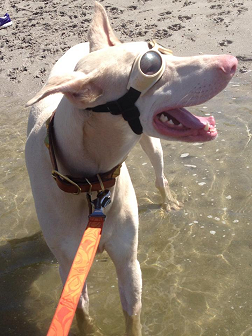
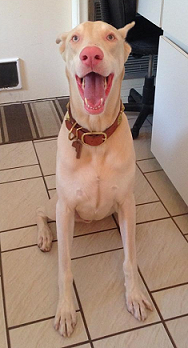
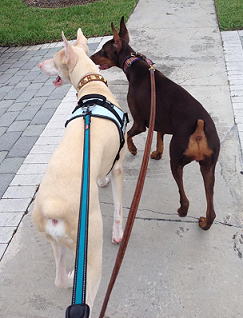
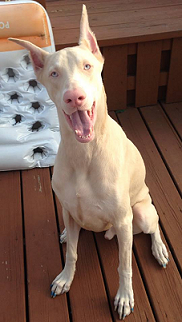
Hades is a rescued white Dobermann. His phaeomelanin areas (tan points) have been diluted to white, and his eumelanin areas are a cream colour. In the first picture Hades is wearing sunglasses to protect his sensitive eyes from the sun. For more photos of Hades see his Facebook page.
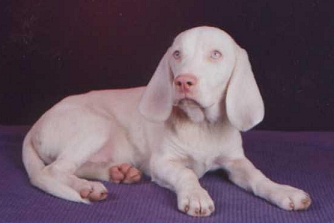
Photo submitted by Darlene of AlaDar Beagles
The Beagle above is a possible example of the same type of albinism as white Dobermanns. The pigment is very pale with little, if any, colour visible. Both parents were tricolours, but as albinism is generally recessive it is probable that the mutation occured further back in this dog's lines.
Dogs of this type do crop up every now and again in a number of breeds, most notably Pekingese and Shih Tzu, but they are generally fairly rare except in cases where breeders have deliberately selected for them. Albinism in Shih Tzu has also been proven to be due to mutations in SLC45a2.

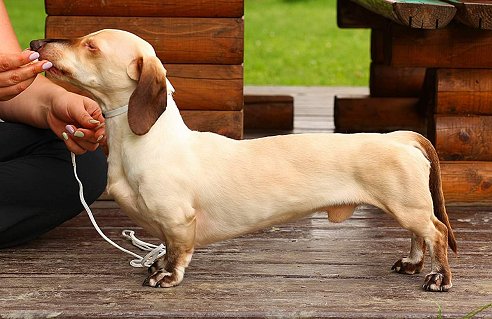

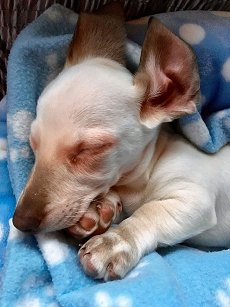
Only one of the two cases of siamese points in dogs has so far been confirmed by genetic testing. More photos of Matysek the Dachshund (above) can be seen on his Facebook page: https://www.facebook.com/Color-Point-Dog-112045217154840. His owner has kindly allowed me to reproduce a few of them here.
Matysek is genetically tan-pointed (atat) - you can see the remnants of the pattern on his face and feet, and puppy photos show him to have been born into a litter of black-and-tans. His phaeomelenin has almost entirely disappeared (been diluted to white, as is clear on the sides of his muzzle), and only eumelanin remains on his points. His eyes are blue, with red/pink pupils. He is known to be sterile, however as this gene is recessive, carriers of the gene will also exist in his lines (the mutation must have occured in one of his ancestors). It is not known currently whether all dogs with two copies of this new gene will be sterile, and we won't know unless more dogs with this mutation appear. The only other dog thought to have it was a Russian stray that is known only from photographs.

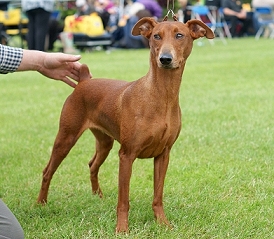
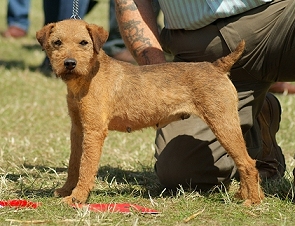
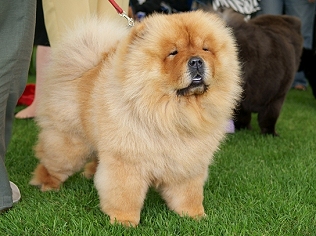
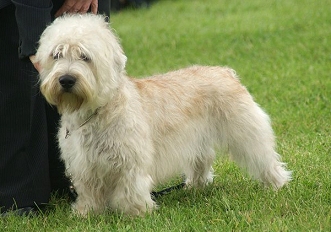
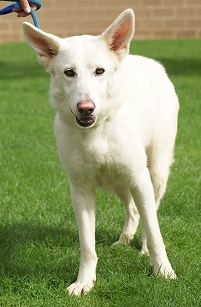
The above photos show the range of phaeomelanin colour in recessive red and sable dogs, from deep red to white.
However, it has now been shown that ivory and white dogs do not have any mutations on the C locus. As it turns out, phaeomelanin intensity is very complex and controlled by a number of different genes at different loci, two of which have so far been located.

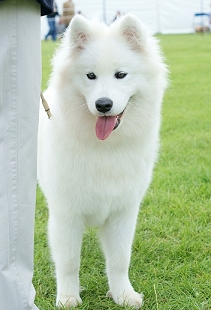

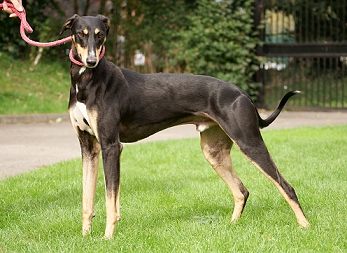
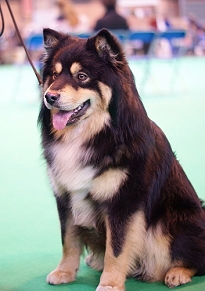
Both of these dogs have tan points (atat) which have been affected by some form of phaeomelanin dilution. Both also have white markings, which are distinct from their tan areas. However, on some dogs the phaeomelanin dilution may be so extreme that it is difficult to tell the difference between white markings and tan points (see the Schnauzer section below). On these dogs, the pattern of the markings is often a giveaway, as white markings are irregular and rarely symmetrical.

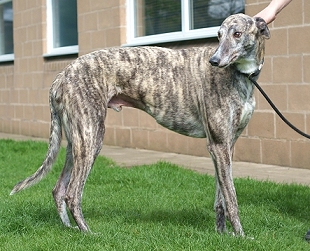
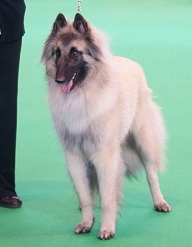
Phaeomelanin dilution affects any and all phaeomelanin in the coat, as these two dogs show. The first is a brindle and the second a masked sable. As you can see, the red in the coat is washed-out and greyish, but the black is unaffected.

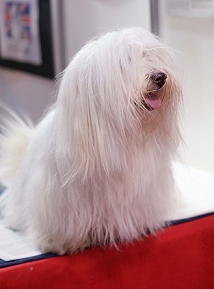
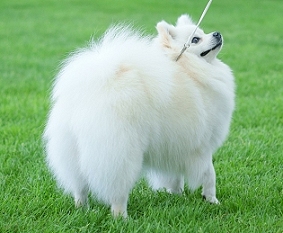
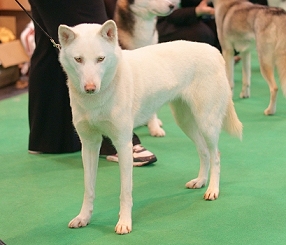
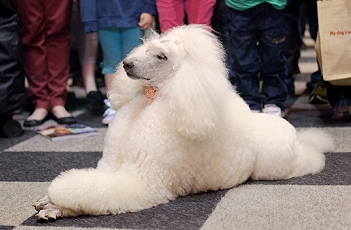
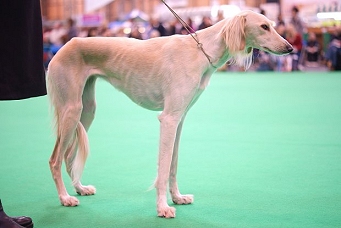
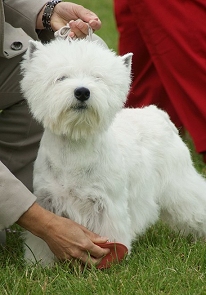
All of these dogs are examples of recessive reds (ee) and clear sables with the strongest red dilution. Their colour varies from cream to white. Breeds with this combination
of genes include Bichon Frise, Samoyed, American Eskimo, German Spitz, Maltese, Bolognese, Akita, Shiba Inu, Saluki, Anatolian Shepherd, Labrador, Komondor, Puli, and Pekingese, among
others.

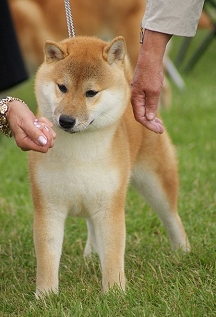
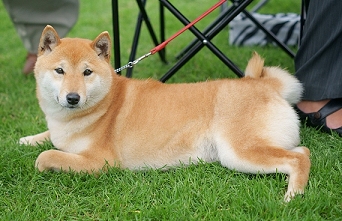
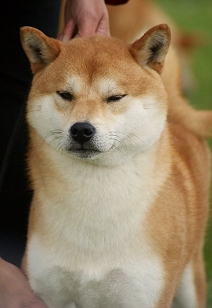
Akitas and Shiba Inu have been bred specifically for strong urajiro markings, however a wide range of other breeds also have them (often in a slightly more subtle form).
Interestingly, the fact that urajiro occurs with and doesn't affect black masks means that it can't be located on the E locus (unlike domino).
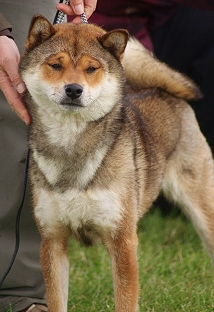
Shaded sable Shiba Inu with clear urajiro (causing only the tan/red in specific areas to lighten to white - note how the rest of the tan remains a rich shade).

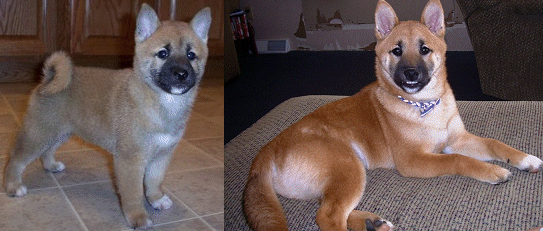
Jersey here, belonging to princesstiffany from PCG, shows urajiro on a puppy and an adult. He also has a few white markings (on his chest, toes and trim), which are not urajiro - you can easily tell the difference by the sharp edges on the white markings, and their asymmetry compared to the urajiro areas. Notice how his black mask has not been affected by the urajiro.

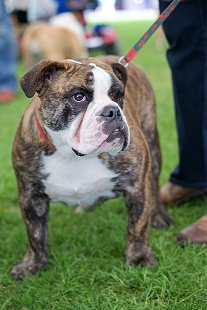
Urajiro affects all phaeomelanin pigment, so brindle dogs can be urajiro too. This Bulldog shows a lightening of the red brindle base
on its cheeks, chest and the inside of its legs. The result is that the base of the brindle in those areas appears greyish rather than reddish. This is evidence of a pigment-restricting
phaeomelanin dilution gene in breeds other than the Shiba Inu and Akita. It's unclear whether it's exactly the same gene as urajiro, or just a very similar one.

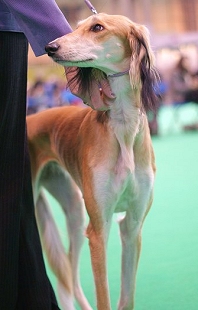
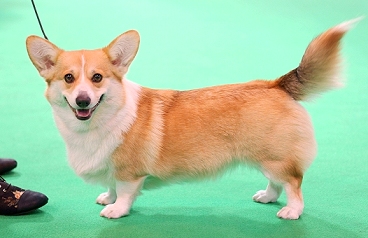
The Saluki and Pembroke Welsh Corgi above also show an urajiro-like pattern. At first glance it looks like the Saluki has irish spotting, but the white goes up the inside of the legs and forms pips above the eyes, just like in urajiro. However, Salukis are known to have the domino/grizzle gene (Eg), so it's possible that this dog is in fact a sable domino. Are the white points from the domino gene or does this dog also have urajiro? It's a tricky case, and without a test for urajiro we'll probably never know.
The Corgi isn't a domino (it doesn't occur in the breed), and does actually have
irish spotting as well as the urajiro pattern. We can tell this by the very regular distribution of white on the face, forming symettrical cheek patches and eye pips.

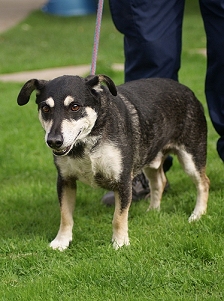
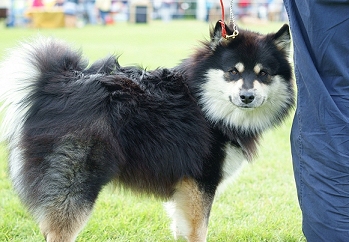
Here are another two dogs that show the potential confusion between domino (Ed / g /h) and urajiro. Finnish Lapphunds (on the right) are known to have Northern domino (Ed), and this large tan point pattern often seems to be associated with domino carriers (one copy of the domino allele and one of E), or sometimes even with true dominos.
The terrier on the left is not a breed type known to have domino, however as it is clearly a crossbreed it's possible it is mixed with a breed such as the Chihuahua, which has the same type of domino as the Finnish Lapphund. Theoretically, a cross between a Chihuahua and a Jack Russell terrier type would result in a domino carrier - EEd - as JRTs are usually E or EM.
Interestingly, similar rich tan areas on the legs are often seen in domino huskies and malamutes.

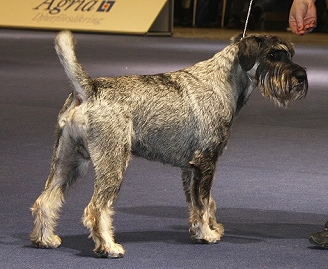
This salt-and-pepper Schnauzer (photo taken by Jessica Pilhede) gives an important clue as to which gene is really responsible for this
colour. Some of its hairs have black tips. Tipped/banded hair is characteristic of agouti (aw). Yep, this Schnauzer is "wolf grey", like a Keeshond. Many Schnauzers have very short fur due to stripping for the show ring, so often banding isn't visible.
The white markings are a natural part of the agouti pattern - usually they are red or cream, but on Schnauzers they are diluted to
white by extreme phaeomelanin dilution, which also causes the scattered red hairs in the rest of the coat to turn to white (giving the salt-and-pepper effect).
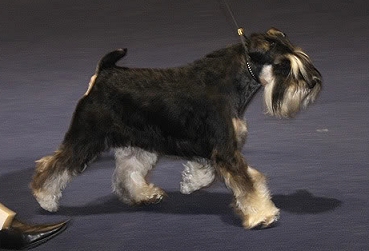

awawKBKBEE - homozygous for wolf grey, black and normal extension. Will be black (genetically wolf grey).
atatKBkyee - homozygous for tan points and recessive red, heterozygous for black. Will be white (genetically black and black-and-silver).
awatkykyEE - homozygous for non-black and normal extension, heterozygous for wolf grey and tan points. Will be salt-and-pepper (wolf grey is more dominant than tan points).
atatkykyEE - homozygous for tan points, non-black and normal extension. Will be black-and-silver (this and atatkykyEe are actually the
only genotypes which will result in a black-and-silver, making it just about the most recessive Schnauzer colour).

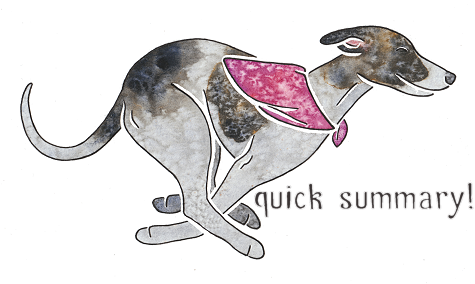
No time to read the whole thing? Here's the quick version!

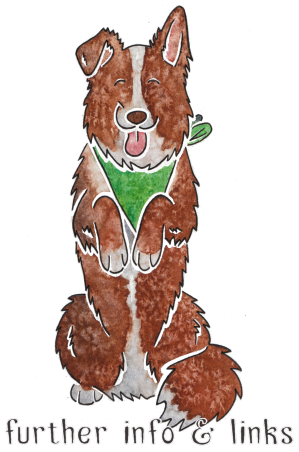
A Partial Gene Deletion of SLC45A2 Causes Oculocutaneous Albinism in Doberman Pinscher Dogs: http://journals.plos.org/plosone/article?id=10.1371/journal.pone.0092127
A missense mutation in SLC45A2 is associated with albinism in several small long haired dog breeds: http://datadryad.org/resource/doi:10.5061/dryad.53kh1
Identification of a Missense Variant in MFSD12 Involved in Dilution of Phaeomelanin Leading to White or Cream Coat Color in Dogs: https://www.mdpi.com/2073-4425/10/5/386/htm
Pigment Intensity in Dogs is Associated with a Copy Number Variant Upstream of KITLG: https://www.mdpi.com/2073-4425/11/1/75

